Note to Readers: Publisher does not guarantee quality or access to any included digital components if book is purchased through a third-party seller.
This innovative text delivers more than 40 evidence-based teaching strategies that educators can use to engage nursing students and enhance their learning in a variety of teaching environments. It provides a wealth of new teaching designs both novice and experienced faculty can use to inspire and motivate learners in the classroom through simulation, online, and in community or hospital settings. Strategies developed by leading clinical nursing and health educators characterize nursing education as a dynamic and highly specialized field that stems from meaningful interactions between learners and educators.
For ease of comparison, each practical teaching strategy is organized in a consistent format to include student-centered competencies and nursing education accreditation standards. The text also provides a template and a step-by-step guide on how to customize the strategies to fit the needs of learners and educators. The designs include an emphasis on applications of technologically enhanced innovations in nursing education, interdisciplinary collaboration, and the use of the humanities and art. This text answers the ongoing call for interprofessional education necessary to prepare the next generation of expert nurses in the rapidly changing environment of healthcare.
- Key Features:
- Evidence-based research used in the development of each teaching strategy
- Groundbreaking practices in a variety of environments will challenge the discipline and spark additional innovations throughout nursing
- Each chapter provides optimal learning outcomes and teaching objectives, preparation resources, modules of implementation, methods to evaluate the effectiveness of each strategy, outlined limitations, and accreditation standards
- Instructor’s Manual included
विषयसूची
Contributors
Foreword Joyce J. Fitzpatrick, Ph D, MBA, RN, FAAN, FNAP, FAANP
Preface
Acknowledgments
PART I: DIDACTIC TEACHING STRATEGIES
1. Cultivating Diagnostic Decision-Making With Problem-Based Learning: From Most Likely to Least Likely
2.
Nursing Tutorials for Student Success3.
Critical Thinking Innovation and the Nursing Process: Sunflower Diagram4.
Prescriptive Journaling5.
PEARLS: Modified Problem-Based Learning for Building Advanced Scientific Foundations, Promoting Critical Thinking, and Facilitating Role Transition in Early Advanced Practice Nursing Students6.
Self-Care Strategies to Foster Well-Being7.
Nursing Ethics and Health Policy Poster Assignment and Poster Session8.
Public Health Crisis Capstone Presentations to Learn Public Health Nursing Competencies and Roles9.
Integrating Ethics Across the Curricula: Innovations in Undergraduate and Graduate Nursing Education10.
Team-Based Learning in a First-Year Nursing Informatics Course11.
Human-Centered Design Thinking and Clinical Workflows in Nursing Informatics12.
Conducting a Health Impact Assessment to Develop Population Health Competencies: An Example of Problem-Based Learning13.
Communicating With Vulnerable Youth and Families14.
Integrating NCLEX® and Practice Readiness in an Undergraduate Leadership Course15.
Critical Reflections16.
Facilitating Active Learning and Critical Thinking in Large Classrooms Utilizing Collaborative Learning and Technology17.
From Cyberspace to Classroom Space18.
Bringing Research to Life for Undergraduate Nursing Students Using a Design Thinking Model19.
Innovative Use of Concept Care Planning in a Large Class20.
Hot Topic Thinkoffs: Classroom-Based Experiential Learning Through Student Nurse Debates21.
Refining Assessment Skills With Artwork and Photographs22.
Innovations in SANE Program Education: Introduction of Mock Trials23.
Role Play for Qualitative Interviewing Skills24.
Pathophysiology in Action Through the Use of Unfolding Case Studies25.
Developing Advocacies in Nursing Courses: Nurturing Compassion and Leadership26.
Using the Power of Art to Teach Evidence-Based PracticePART II: CLINICAL/SIMULATION TEACHING STRATEGIES
27. Simulations for the APRN: Utilizing a Standardized Template to Ensure Best Practices
28.
Mock Page Exercise for the Development of Communication and Clinical Decision-Making Skills29.
Use of Case Scenarios and Simulation in Teaching Critical Care Nursing30.
Learning Motivational Interviewing Through the Experiential Lenses of Provider and Patient31.
Use of Case Scenario and Tabletop Exercise in Teaching Field Triage in Disaster Nursing32.
Interprofessional Simulation: Perioperative Crisis Management33.
The Use of Reflective Journaling to Decrease Anxiety in Providing End-of-Life Care in the Critical Care Clinical Setting34.
Integrating Interprofessional Education Into Public Health Clinical Settings35.
Case Scenarios and Simulations for Student Success36.
Integration of Mixed Modality Technology to Promote Learning in the Use of Longitudinal Rolling Case Studies37.
Effective Debriefing in Simulation38.
Standardized Handoff for Quality and Safety39.
Bedside Rounding: A Patient- and Learner-Centered Post-Conference40.
Think Aloud and Expert Modeling41.
Teaching Essential Communication Strategies for a Comprehensive Well-Child Visit Using Simulation With Family Nurse Practitioner Students42.
Interprofessional Clinical Education for APRNs and Dental Students43.
Patient Care in an Intense Situation Within an Unstructured Environment44.
Strategies to Facilitate Learning in the Large Classroom: Team-Based Learning and the Use of Professional Social MediaIndex
लेखक के बारे में
Celeste M. Alfes, DNP, MSN, MBA, RN, CNE, CHSE-A, FAAN, is professor and assistant dean of academic affairs at the Frances Payne Bolton School of Nursing, Case Western Reserve University (CWRU) in Cleveland, Ohio. She earned a BSN (University of Akron), a MSN (University of Akron), a DNP (CWRU), and an MBA from CWRU. Dr. Alfes has 33 years of experience as a nurse educator and has made significant contributions pioneering simulation training including the development of North America’s first high-fidelity helicopter simulator adapted for flight nurse training. Dr. Alfes is a fellow in the American Academy of Nursing; a Fulbright Specialist at the University of Rome Tor Vergata, Italy; an Inaugural Coldiron Fellow, Marian K. Shaughnessy Nurse Leadership Academy (MKSNLA), American Organization for Nursing Leadership, American Nurses Association, and Healthcare Financial Management Association; a member of the MKSNLA Founders Circle; a recent visiting professor at the University of L’Aquila, Italy, and Aichi Medical University, Japan; and a National League for Nursing simulation leader and consultant. Dr. Alfes is a reviewer for the National Science Foundation and a regular contributor to the journals Nurse Leader, Nursing Education Perspectives, and Clinical Simulation in Nursing. Dr. Alfes has published several books with Springer Publishing Company including Clinical Simulations for the Advanced Practice Nurse (2020), Strategies for Teaching Nursing (2020), and the Guide to Mastery in Clinical Nursing (2019) series.












